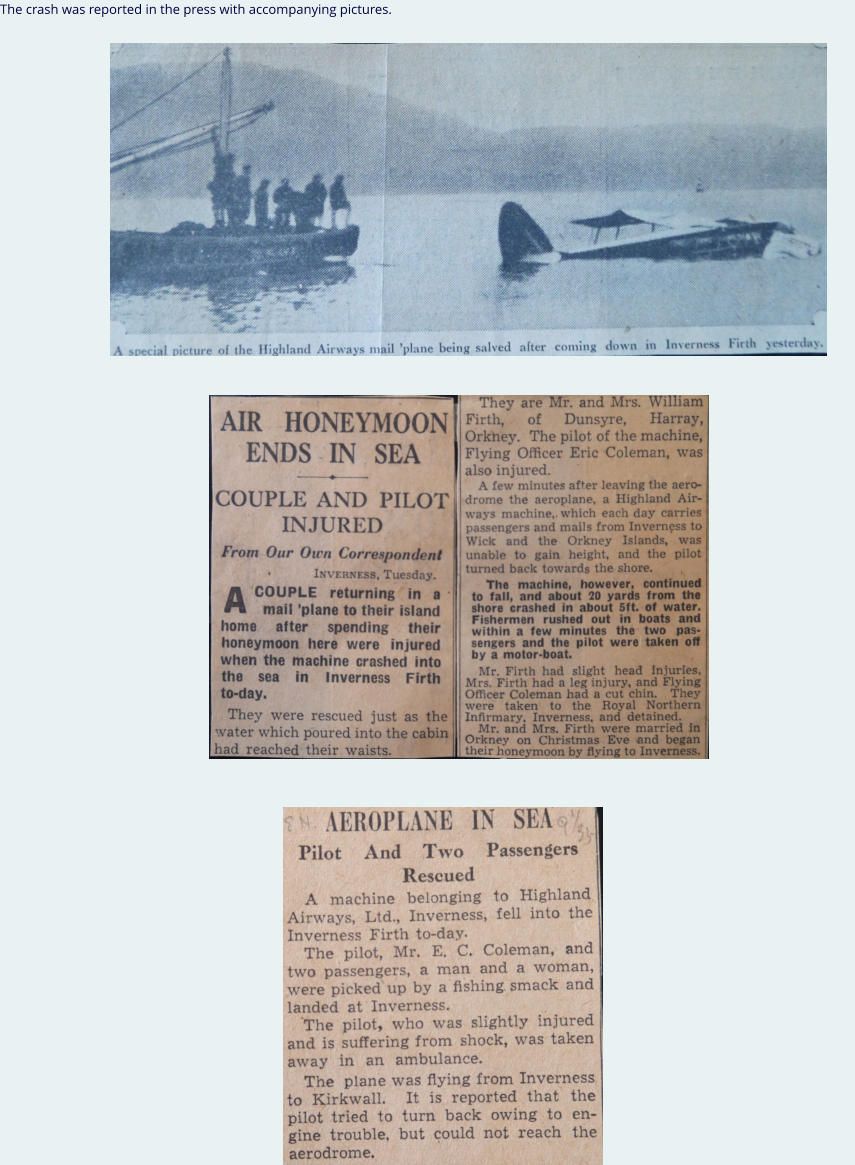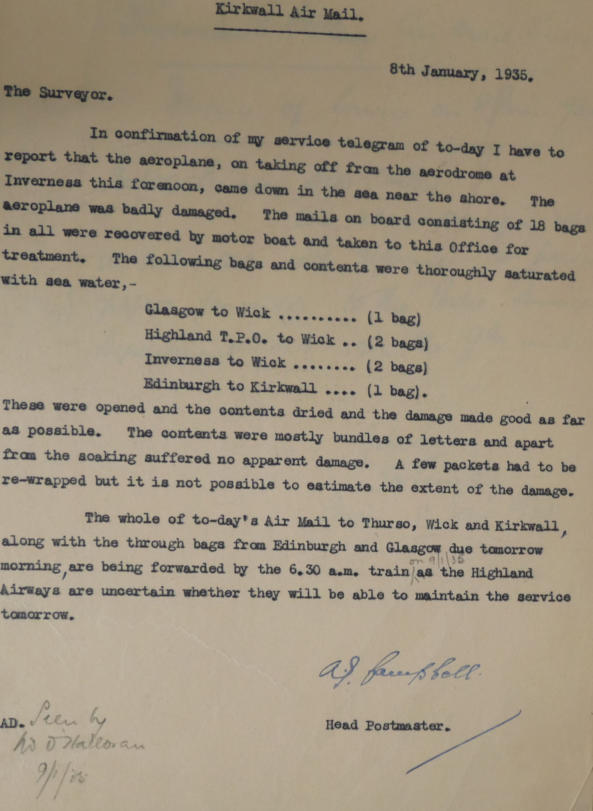
Highland Airways - Crash January 7th 1935
Highland AIrways Crash. Coleman Letter
On January 7 th 1935, Captain Eric Coleman was transporting 2 honeymooners from Inverness. Shortly after take-off the plane ran into trouble and crashed into the Moray Firth. There were only minor injuries, and the mail was saved though a little bit wet. Coleman wrote a letter to the GPO explaining the incident.
In his autobiography, Ted Fresson is clearly not impressed by the incident and the piloting skills, essentially refuting Coleman’s account (not in the letter
which appears to address the issue of mail, perhaps to the GPO). Fresson says: “He was replaced by a pilot, who shall remain nameless, and who had
recently returned from a short RAF service commission. He was a good pilot in his not very long stay with the company and managed to earn us wide
publicity by dumping a Honeymoon couple in the Moray Firth, alongside the Inverness Airfield, just after take-off. It was not until the after the
immersion, when the good lady lost her teeth in the icy cold ducking in freezing weather, when the very new husband found out that her teeth were not
her own. There was the devil to pay and we faced a serious claim for hurt feelings and ‘damaged baggage’. The reason for the forced descent was never
really cleared up. The pilot claimed that ice on the main planes had contributed to the airplane failing to stay airborne after taking off, but I doubt that
explanation, as the plane was only lightly loaded….Our nameless pilot had more trouble ahead of him, for a year or so later, taking off at Wideford in
Kirkwall, he failed to clear the dyke and dumped six passengers into a wide pit on the other side of the airfield. Two were injured, but fortunately not
seriously and the other four were badly shaken. Those two crashes lost him the confidence of the travelling public and he left to join Imperial Airways at
Croydon.”

Mrs Smith the recipient of the letter described receiving it.
Another example sent to Caithness, also signed by
the pilot and the two passengers.

Copyright
© 2022 Robert Farquharson All Rights Reserved




British Internal Airmails of the 1930’s
Another example sent to Caithness, also signed by
the pilot and the two passengers.
The mail at the back of the plane was saved from a
ducking as can be seen from this example, where the
stamp is intact as opposed to the previous examples
where the stamp has been washed off.
The envelope from Inverness to Wick was soaked and
lost its stamp. It was subsequently dried at Inverness.
Signed by the pilot and the two passengers.


The Postmaster at Inverness wrote to the Surveyor (Regional Manager) describing the extent of the damage to the mail bags.

Highland Airways - Crash January 7th 1935
Highland AIrways Crash. Coleman Letter
On January 7 th 1935, Captain Eric Coleman was transporting 2 honeymooners from Inverness. Shortly after take-off the plane ran into trouble and crashed into the Moray Firth. There were only minor injuries, and the mail was saved though a little bit wet. Coleman wrote a letter to the GPO explaining the incident.
In his autobiography, Ted Fresson is clearly not impressed by the incident and the piloting skills, essentially refuting Coleman’s account (not in the letter
which appears to address the issue of mail, perhaps to the GPO). Fresson says: “He was replaced by a pilot, who shall remain nameless, and who had
recently returned from a short RAF service commission. He was a good pilot in his not very long stay with the company and managed to earn us wide
publicity by dumping a Honeymoon couple in the Moray Firth, alongside the Inverness Airfield, just after take-off. It was not until the after the
immersion, when the good lady lost her teeth in the icy cold ducking in freezing weather, when the very new husband found out that her teeth were not
her own. There was the devil to pay and we faced a serious claim for hurt feelings and ‘damaged baggage’. The reason for the forced descent was never
really cleared up. The pilot claimed that ice on the main planes had contributed to the airplane failing to stay airborne after taking off, but I doubt that
explanation, as the plane was only lightly loaded….Our nameless pilot had more trouble ahead of him, for a year or so later, taking off at Wideford in
Kirkwall, he failed to clear the dyke and dumped six passengers into a wide pit on the other side of the airfield. Two were injured, but fortunately not
seriously and the other four were badly shaken. Those two crashes lost him the confidence of the travelling public and he left to join Imperial Airways at
Croydon.”


The crash was reported in the press with accompanying pictures.

Copyright
© 2020 Robert Farquharson All Rights Reserved


British Internal Airmails of the 1930’s



































